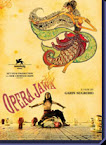"Opera Jawa" Movie Review (2)
Indonesian musical from filmmaker Garin Nugroho that retells parts of the Hindu epic the Ramayana.
There are no two ways of getting about it - an Indonesian film that retells part of the 'Ramayana' using a selection of creative practices both traditional (gamelan music, wayang orang dance) and modern (art installations, mostly consisting of mannequins, and things on fire, notably said mannequins) is a specialist proposition.
It's hard to guess what audience Opera Jawa will get in the UK - hardcore arthouse specialists with an interest in Southeast Asia? Indonesian ex-pats? Good luck though to director-producer-co-writer Garin Nugroho (whose previous film, Serambi, told a story of tsunami victims and was in the Un Certain Regard category at Cannes). Nugroho was, apparently, "practically the only director who continued to produce films with an aesthetical [sic] quality which varied from film to film" during the 1990s, a decade when the Indonesian film industry "appeared to have suffered an untimely death."
Opera Jawa takes the episode 'The Abduction of Sita' (or 'Sinta Obong' in Indonesia) from the Ramayana. Although Indonesia is predominantly a Muslim country, prior to the rise to dominance of Islam (in the 16th century) it was ruled by a Hindu kingdom, and Hinduism (alongside Buddhism, which also had a strong historical presence) remain central in Indonesia culture. While it's only really Bali that retains a substantial Hindu population, the Ramayana and Mahabharata stories have a strong presence in the traditions of dance, theatre and shadow puppetry.
Here, Nugroho tells the story of potter Setio (Miroto) and his wife Siti (Devi), who, along with Ludiro (Supriyanto) - the head of the village stockyards and both a rich man and something of a hoodlum - used to dance the parts of Rama, Sinta and Rahwana in the traditional wayang orang dance version of the 'Ramayana'. Siti seems pretty bored, while Setio is preoccupied with his business, which leaves an opening for Ludiro to try and seduce Sit, with whom he is madly in love. Essentially, the three start replaying the roles they formally inhabited for the wayang orang.
All this is realised in dance and song. Not a single line of dialogue is spoken. If you're a fan of gamelan, that's fine, but if you're unfamiliar with it, it's a bit of a struggle, as gamelan is a music so utterly different from our Western traditions of classical music (and from our Western-African hybrid pop music traditions) that it can sound difficult and discordant to unfamiliar ears. Though there is one hugely obese guy who pops up playing a ukulele and has a particularly amazing, bluesy voice. The fact that the sound recording is somewhat rough (with a lot of background noise and chatter) doesn't help.
More accessible is much of the imagery, with some impressive tableau - an interior lit by dozens of candles shaped like lotus blossoms; red fabric draped from the home of Ludiro across the landscape to Siti's house; lean, wiry dancers with masks worn on top of their heads; a multicoloured funeral procession on a beach. Not all the imagery is so great though. Nugroho throws a lot of installation art into the mix, which doesn't all work, and there's a lot of impenetrable symbolism (what's with all the wicker cones for example?)
The film is billed as a requiem to those who died from violence and natural disasters, but it's as if Nugroho is trying to bolt too much on. Marchers chanting "Down with exploitation" distracts from the core story, which feels disjointed at the best of times, though whether this is to do with the film's storytelling, or our own lack of familiarity with its means of expression, is uncertain.
Verdict
With some remarkable dance and spectacle, this is a unique film, but not exactly one with broad appeal.
Opera Jawa review by Daniel Etherington at Channel4.com




0 komentar:
Post a Comment